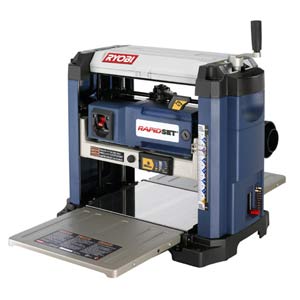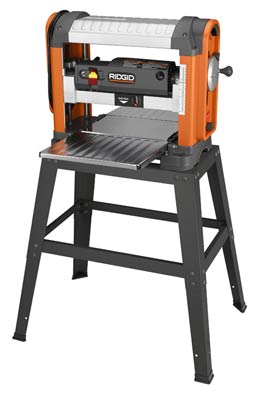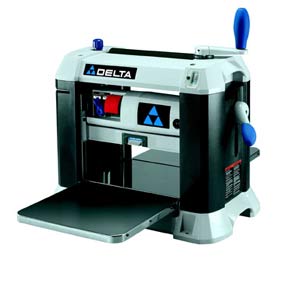MULTI PLANER TEST
or
THREE MARVELOUS MACHINES
Greetings from John’s Tool Crib!
What a busy month for me as I am trying to do
at least seven articles to let your loved ones know what to
put under your tree this holiday season. At one point I even
lost this whole article because of a computer glitch. Luckily,
my fantastic wife put the file on another site and saved it
there. Without that move, I would have had to write it all over
again with just my notes. I tried to get more machines to test,
but some manufacturers wouldn’t help out, and I didn’t
have contact numbers for others.
DeWalt had just come out with a new planer, and
they didn’t have enough to go around, but they sent a
12” double compound sliding miter saw for my next multi-tool
report. They sent the list of features and specifications for
both of their new planers and pictures. If you are considering
buying a DeWalt machine, they are among the top rated of all
tool builders. DeWalt, RIDGID, DELTA and RYOBI all supply high
end tools for professional use.

In my opening statement from my bio, I said I
would only test the least expensive tools that most of us would
buy. Since then, I have been informed that plenty of builders
out in the reading world would like to read about all the choices
in any category. So this is why I am doing some multi-tool reviews.
I want to show all of the options available. I can now see also
that the high end tools are worth every penny for what you get.
The three that did send machines were RYOBI,
DELTA and RIDGID. I have tested each one extensively and have
ground to chips many board feet of quality lumber to bring you
the results. First, I would like to give a lesson on what is
referred to as snipe. Snipe is a condition where the wood going
through your planer comes out at the very end with a few inches
or just a groove of wood that has been cut deeper than the rest
of the board. It can happen at the beginning of the cut or more
often at the end of planing.
Remember that snipe has been virtually eliminated
from modern planers by the engineers who design them. All of
the owners’ manuals give detailed instructions on how
to adjust your machine for snipe-free operation. I took my time
and set up each machine. I ran many types of wood through each
one with impressive results. On a newer, well designed planer
like the ones I tested, you should encounter very little snipe.
If snipe occurs on every board then you must adjust your machine
to rid yourself of the snipe. If you only get snipe once in
a while, reverse the ends of the board you insert into the planer.
If you cut against the grain snipe will happen. But when you
reverse the board you can rid yourself of the snipe.
Another thing to remember is that the planer itself
cannot balance long boards. The further a board must go without
support the higher the likelihood of snipe. With the planer,
you should always purchase roller supports to support the lumber
coming from the planer. I made a timely purchase of roller stands
at a store called Big Lots that sells closeouts from large chain
stores and sells them at ridiculously low prices. They were
twelve dollars each. I have seen them on sale at Home Depot
for nineteen dollars. You probably could get by with two but
I recommend three or four. Actually, I like five or six with
boards that measure twelve feet or more. While on the subject
of roller stands I always drill a 1/8th inch hole in the movable
leg of the stand and then screw the stand to the shop floor.
You will find that the board coming out of the planer can flex
down and tip the stand over if it isn’t immobilized.
Now onto the machines, but first this warning:
Just like all power tools these machines must be handled with
respect. You can lift the cutter head of these machines in the
air the full amount of travel and turn them on without having
wood present. All of them have some type of safety feature so
they cannot be turned on without the operator present. Use these
features because the cost of a child or adult’s hand is
beyond calculation. So use the safety devices always and no
horse playing around them. And please do not allow any stupid
people to operate machines as dangerous as these. Safety must
be your #1 concern each and every time you use these machines.

The first machine is the RYOBI AP1300 planer.
I started with the RYOBI because they first came out with the
bench-top planers with their AP10 10” planer about 10
years ago. While it is the least expensive of all three, it
has many excellent features for a planer at this price. The
RYOBI AP1300 has a dust manifold that when hooked to my collection
system removed most of the debris through the manifold. The
planers that could be were hooked up to my 6.5 hp dust collection
system. It is essential that you have some type of collection
even if it’s just a shop vacuum. All of these machines
can make a mountain of chips in a very short amount of time.
It has adjustable input and output tables and has a top mounted
tool area with a convenient lid for storing pencils, rulers
and the planer knife wrench. The double-edged cutters are easy
to change once you master the technique. When one edge becomes
worn you can reverse them and use the other edges for cutting.
You can also slide them from side to side if you chip them,
so it doesn’t leave a mark on your work. The RYOBI planing
results are no less than great.
Even though it is has the lowest price, the RYOBI
AP1300 has top features like a replane set gauge that allows
for 8 depth stops to accurately plane your workpiece to a desired
thickness up to 1 ¾". It has a cutting lock to assure
snipe-free results in any type of wood. The RYOBI AP1300 will
take wood up to 13” wide and 6” tall maximum at
25 feet per minute. The planing depth gauge even measures each
cutting depth before every pass. The maximum cutting depth is
1/8th inch for 6” widths or less. The motor even has externally
available brushes so you can service them rather than sending
it out, as did the other two. Be aware that none of these machines
should be used without hearing and eyesight protection. With
that said, I did not test the machines for sound output, but
be sure to tell your wife what you’re doing, because she
will hear any of them running. RYOBI has a two-year warranty
and a thirty-day return policy that is hard to beat. I can truly
say that the RYOBI AP1300 was a lot more machine than the price
tag lets on. For a first time buyer on a budget or even a seasoned
boat builder without a wood planer this tool will do the job.

Now we move on to one of the best planers I have
ever used. The RIDGID TP1300LS comes with its own stand and
a mile long list of features. One of the RIDGID TP1300LS’s
best features is that almost everything you need to start planing
lumber is inside the box. It has the stand, the waste product
manifold, an extra set of knives and the changing tool. With
every planed board I could see the years of quality tools that
preceded this fine tool. For a single speed planer it gave simply
remarkable results. While being in the middle range price-wise,
it gave top end performance
This RIDGID TP1300LS also has a cutting head
speed of 9,500 RPM’s and a feed rate of 26 feet per minute.
The capacity of this and most small planers is 13” wide
and 6” tall, and the maximum cutting depth is 1/8th inch
and gets its super fine finish with 66 cuts per inch. Any boat
builder could use this tool to plane any type of wood with outstanding
results. It also has oversized input and output tables for extra
support. In fact, they are also fully adjustable. It also has
“IND-I-CUT“! DEPTH MEASUREMENT that instantly measures
cutting depth before each pass. Another feature is “REPEAT-A-CUT"!
DEPTH STOPS with eight adjustable depth stops to precisely plane
work pieces to desired thickness up to 1 ¾" thick.
Still another feature is SOF-TOUCH"! CONTROLS with large
ergonomic knobs that are comfortable and user-friendly.
I found the RIDGID TP1300LS has a very familiar
feel -A feel that my oldest tools give me that guarantees good
results. I even used this planer and the DELTA model to build
my custom built Phillip C. Bolger designed Brick with copper
bottom and red oak exterior lumber with mahogany plywood. Probably
the most expensive Brick built to date, and I haven’t
built the mast or sail yet.
For the RIDGID’s price, I recommend any
boat builder from neophyte to professional take advantage of
RIDGID’s 3-year warranty and a 90-day return policy. You
won’t have any regrets. Like the RYOBI before, the RIDGID
was adjusted to be free of snipe in just a few minutes of tinkering,
at least in my results. The RIDGID TP1300LS provides a superior
surface in all woods. In some wood I had to take out my Radio
Shack hand held 100 X microscope to see that this planer had
been bested. With performance that close in a few species of
wood, this planer is a close second place. Even the RYOBI planer
in my opinion had excellent results.

Now I come to the last planer in this series.
It also has the most features of all the planers tested. DELTA
has a standard 2-year warranty that covers any DELTA machine,
machine part or machine accessory. It is a heavy machine and
with my bad back, I had to have help lifting this beautiful
magic box. The DELTA Industrial Model 22-580 13” two speed
finishing planer is just as described.
It is unfair that I placed this wonderful machine
in with two others designed mainly for small shop use. I can
only say that an amateur boat builder can have custom wood finishes
with all of them but they don’t have to work as hard with
the DELTA. This is the machine dreams are made of. The maximum
width of stock to be planed is still 13” but the height
is 6½” instead of just 6” for a small but
useful increase in size from the other two.
I had a lot of interesting results using this
tool. In the regular mode, the finish is almost as good as the
RIDGID, but the finish from the slower finish speed is spectacular.
Even when I planed red oak the most it needed was a very fine
sanding. That’s a very good result. Of all the planers,
the DELTA needed the least adjustment to remove all snipe. As
I said, the newest engineered planers can and are snipe-free
with common sense and fine-tuning.
Some of you reading this will say to yourself
that you will never need a planer, and you might not. I say
that with the prices of wood going up dramatically all the time,
there will come a point that people will have to resort to gleaning
wood from hardwood pallets, old waterbed frames, and many other
sources rather than spending fortunes at a lumber yard. I do
these things now. When you gather wood of all sizes, you will
need a planer. With any of these planers you can turn rough
wood into beautiful works of natural art. The DELTA sits at
the top of my planer trio, because it is a two-speed finishing
tool and tops the list with the most features that work.
The DELTA weighs 97 pounds, is 23 ¼”
tall, 17 ½” wide and is 27 ¾” deep.
A lot of machinery is packed into that small space. The feed
rate is 20 feet per minute on the slow finish setting and 30
feet per minute on the standard setting. The cuts per inch are
90 and 60 per respectively. The cutter rotates at 10,000 rpm.
It has an oversized on/off switch for safety and a patented
cutterhead lock that stabilizes the cutterhead to virtually
eliminate snipe. Although done in different ways, all of the
planers had this same feature. The DELTA planer features a full-range
depth stop for repeatable thicknesses at any dimension across
the entire height range instead of 1¾“ like the
other two planers. The blade zero indicator sets the cutterhead
to the exact thickness of the material. One of my favorite features
of any planer is on the DELTA. It is the stock transfer roller
built into the top of the planer. This is used to make multiple
passes easy since you just roll the board back over the top
of the machine. In my humble opinion, all planers should have
this very nice feature. Every bearing, bushing, and control
link are built larger on the DELTA planer. Of all the machines,
it had the easiest height adjustment control with an oversized
soft grip handle that made it comfortable. It is a machine built
for heavy use like a commercial boat shop may need. I know that
I could never wear this planer out in the rest of my lifetime.
I also know that a production shop could not wear this planer
out in ten years of use. So if you want an immensely strong,
accurate and dependable tool, the DELTA Model 22-580 industrial
13” two-speed finishing planer could be the one for you.
While planing with these machines I used maple,
ash, Port Orford cedar, walnut, birch, yellow pine and fir.
I made too much saw dust and shavings out of perfectly good
wood. Don’t tell my wife I made dust out of the wood for
her Galileo thermometer holder. I just couldn’t help myself
once the chips started to fly. Make sure you have a lot of lumber
when you purchase any of these planers; once you start you just
can’t stop.
As to what I would pick for my new shop I have
to say any of them. I have to thank RYOBI, DETA, RIDGID and
DeWALT for the help and machines, pictures and specifications
they provided for this article. All of these planers are beautiful
and built tuff like the tools our grandfathers used. I am unable
to pick one that would be called the winner of this review.
Each one has the ability to do what they are intended to do
in a very nice way. As with any tool, as the prices rise so
do the features, accessories, size and weight.
The RYOBI would be good for the first time amateur
and the professional also. For a little more money, you get
a complete package with the RIDGID with almost nothing else
to buy. It is also a better planer and would compliment any
shop. The DELTA planer is as solid as granite rock. It is built
tough for the long haul, but is still aesthetically pleasing
to the eye. It also had the overall best performance. I would
call this test the best of the best. None of these planers showed
any faults; they are all sound buys in their respective price
ranges. Let the chips fly in your shop!
So long from my tool crib,
John

